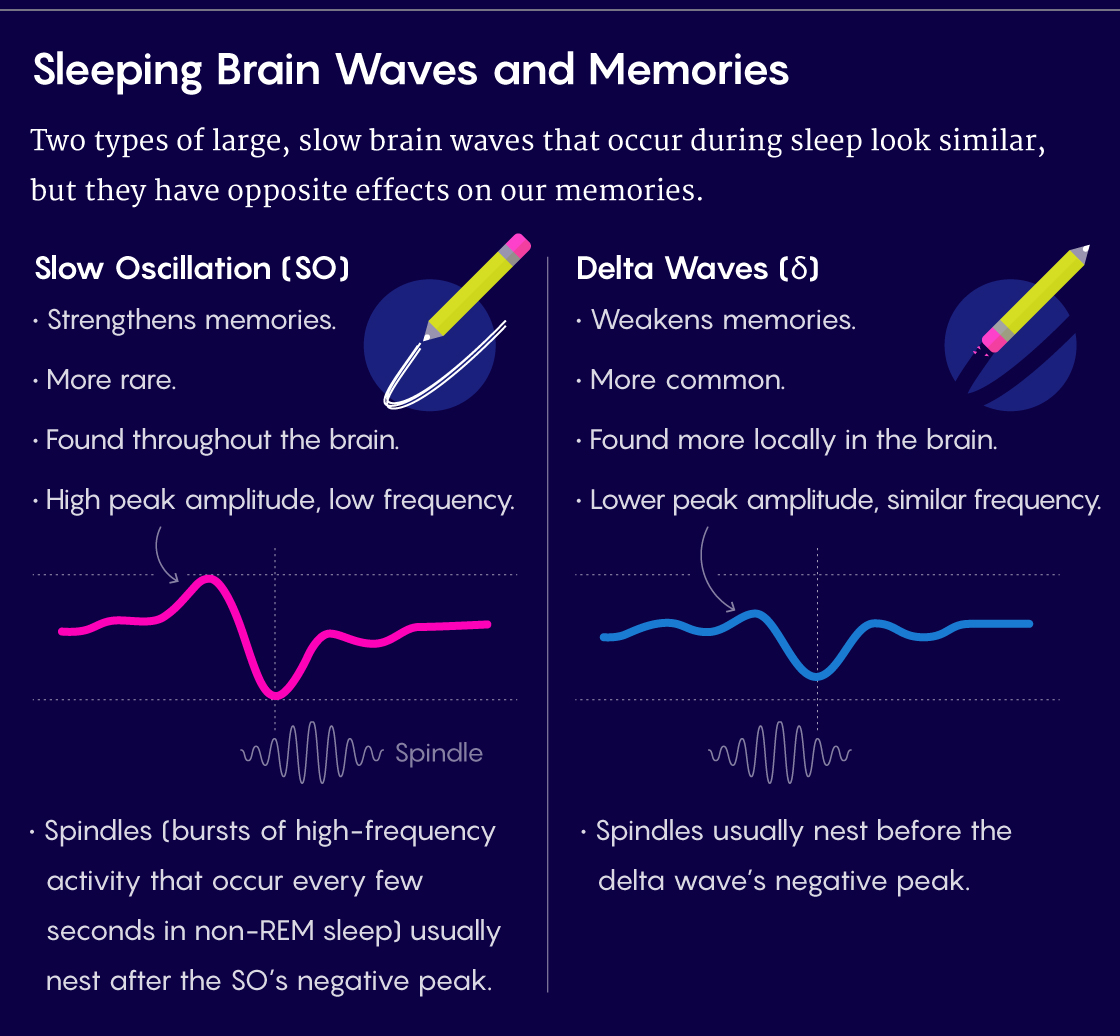Dueling Brain Waves Anchor or Erase Learning During Sleep
Introduction
The brain collects far more memories than it can keep. We absorb new information throughout the day, but retain only some overnight and beyond. Sleep seems crucial to this balance of learning and forgetting, solidifying some memories and eroding others through the brain’s patterns of electrical signaling, but the mechanisms at work have been unclear. Research reported earlier this month, however, has chipped away at the mystery by isolating the opposing functions of two kinds of brain waves: one that strengthens memories and one that weakens them.
Simply by distinguishing these brain waves from each other, the researchers began to form an explanation that reconciles competing theories about how the brain processes memories to retain some and lose others. There was a gap in our understanding of how sleep could be important both for remembering and forgetting, said Karunesh Ganguly, an associate professor of neurology at the University of California, San Francisco, and the senior author on the study.
Theories about memory consolidation generally fall into one of two camps, and some evidence supports each of them. One attributes long-term learning to patterns of brain activity that are reenacted during sleep. These ensembles of neural firing mimic the signals involved in the original learning, and that repetition strengthens the synaptic connections between the neurons to ingrain the memory. Without reactivation, other connections are in theory not fortified, and those memories should wither away.
As an alternative, many researchers put stock in the idea of “synaptic downscaling,” in which the brain more actively clears itself of less useful memories. Because learning involves neural activity that strengthens brain connections, it becomes an energy drain. During sleep, less energy goes into the connections, allowing those with less long-term importance to weaken. Removing this background noise from unneeded memories clarifies the brain’s signals and keeps it more efficient.
The new research bridges the divide between these theories by looking at the roles in memory retention of different brain wave patterns associated with sleep.
Decades of research on the reinforcement and loss of memories have focused attention on two brain wave patterns: slow oscillations and “sleep spindles.” Slow oscillations, characterized by high peaks and low frequency, sweep throughout much of the brain. They become critical for memory consolidation when coupled with sleep spindles, bursts of high-frequency activity that occur every few seconds in non-REM sleep (the generally dreamless state that lacks rapid eye movements). In contrast, delta waves are slightly smaller than slow oscillations and tend to show up locally within the brain. Because slow oscillations and delta waves commonly show up together during sleep and can be hard to distinguish from each other, they are often grouped together as slow waves.
But recognizing the distinction between slow oscillations and delta waves was the key to the discoveries made in the newly published research.
Jaekyung Kim, a postdoctoral scholar in neurology at UCSF and lead author of the study, worked with Tanuj Gulati, an assistant professor of biomedical sciences and neurology at Cedars-Sinai Medical Center. With rewards, they trained rats in a new skill, which involved a specific neural activity in the motor cortex. At night, while the rats slept, they suppressed selected wave patterns in the animals’ brains. The next day, they tested whether the rats’ memory for the new skill had improved or worsened as a clue to the functions of the different brain waves.
Kim used precise criteria to separate the slow oscillations from the delta waves in his recordings of the rats’ brains, drawing on distinctions first observed in a study of cats more than 20 years ago. When he and his colleagues knocked out slow oscillations, the rats’ learning deteriorated — as expected, given the known importance of slow oscillations for consolidating memories.
But to the researchers’ surprise, when they disrupted delta waves, they saw the opposite effect: The rats’ memories improved.
“I had no idea that silencing slow oscillations would have a different effect than silencing delta oscillations,” said Gina Poe, a professor of integrated biology and physiology at the University of California, Los Angeles. She did not anticipate that the differences between these waves would hold such significance, but she said the study’s results fell in line with a number of other findings. “It’s kind of like the missing puzzle piece,” she added.
These competing functions suggest mechanisms for both central theories of memory consolidation. Ganguly’s team had previously linked spindles nested with slow oscillations to the reactivation of ensembles of neural activity and the strengthening of memory. At the same time, delta waves seem to degrade memories, perhaps by weakening brain connections in some form of synaptic downscaling.

Lucy Reading-Ikkanda/Quanta Magazine
Delta waves had not been studied extensively in this context, Ganguly said. Taking their effects into account revealed the balance between these two kinds of waves — and between learning and forgetting. “It’s a push-pull system,” he said. “There’s a dynamic in the brain that’s able to switch things on and off based on other information.”
In effect, slow oscillations and delta waves compete to align in time with spindles. The rate at which spindles synchronize with slow oscillations correlates with how well the rats remember their new skill, but factoring in the synchronization rates of both slow oscillations and delta waves generates a far better predictor. It’s not just slow oscillations that affect learning; delta waves seem influential as well. “The two of them might be really critical for not just remembering, but remembering the right things at the right time,” said Bryce Mander, an assistant professor of psychiatry and human behavior at the University of California, Irvine.
But this balance is delicate and could be upset by anything from brain trauma to sleep deprivation. Since alterations in brain waves often follow brain injury, the proportions of delta waves and slow oscillations might contribute to the lingering memory deficits, Ganguly said. And the relationship between these waves could play a role in a far more common phenomenon — the cognitive decline that comes with aging.
Ganguly and his team observed in their research that sleep spindles behave differently with different waves. With slow oscillations, the spindles tend to couple with one phase of the wave, but they lock to a different phase of delta waves. Spindles show a similar shift in aging brains, Mander said, because they begin to nest at a different point on slow waves. If delta waves are more prevalent in aging brains, it could help to explain this change.
Delta waves have also been more directly tied to dementia. In brains that show a buildup of amyloid plaques, a hallmark of Alzheimer’s disease, delta waves proliferate. In advanced Alzheimer’s, they are found not just in sleep, but in wakefulness as well. “You see delta waves just show up everywhere,” Mander said. Their presence hints at how memory impairment could take shape in the brain.
Expanding the study of these competing brain waves to new areas like aging will depend on whether this mechanism applies to other kinds of learning. For example, the learning of motor skills relies on brain areas that are not as involved with other types of learning, so it is not yet clear if this competing-brain-wave mechanism will be present in all forms of memory, Poe said.
The realization that delta waves may have a function distinct from slow oscillations also suggests a promising approach to several problems in sleep and memory research. Some medications that improve sleep, for example, still fail to improve learning and memory; future studies of the balance of slow waves produced under their influence might illuminate why. Data that tracks slow waves during sleep might reveal further new insights into the separate effects of slow oscillations and delta waves. It might also eventually prove possible to enhance memories by disrupting delta waves rather than by aiming to promote more slow oscillations. Studies of brain activity in people with extraordinary memories might also yield concepts for interventions to benefit learning. “This paper opens up a whole new field of study,” Mander said.
One question still hanging after Kim’s work is why we and other animals need to sleep as much as we do. The evidence suggests that the coupling of slow waves with sleep spindles occupies only seconds out of hours of sleep; only a few instances of this coupling are needed to create long-term changes in the durability of memories. “That’s enough to cause our circuits to reshape themselves,” Poe said.



